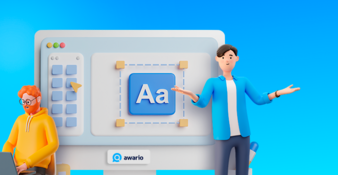Marvel vs. DC: Who wins the battle on social media?

Today's superheroes come in all shapes and sizes: Super Spider, Captain Cat, Wonder Wolverine, and, of course, Robert Downey Jr. We all have our favorites, and most of them come from two superhero universes — DC and Marvel. Apart from being an overall exciting thing to study, Marvel vs. DC is an iconic brand battle, and there's a lot to discover about it both for marketers and the brands' global audiences.
By the powers of Awario, we've been granted the extraordinary social media monitoring abilities, which means we get to explore brand rivalries through the lens of social media and the people behind it. This type of research is called social listening analysis, and that's what we'll do for Marvel and DC.
To run a social listening analysis, we fire up 24/7 monitoring of mentions of our keywords — DC and Marvel in this case — on Twitter, Facebook, Instagram, YouTube, and Reddit. Now, starting social media monitoring is usually a matter of putting in a brand name; however, given that both Marvel and DC are common words, we need to pull out the big guns and use the Boolean search mode to narrow our monitoring down to relevant results only.
Boolean search allows us to create complex queries by using various operators. For example, we used the near/ operator to specify that we only want those mentions of DC that have such words as universe, superhero, and comics in its proximity.
Once social listening is underway, we look at stats, social data analytics, and individual posts to find out what social media thinks of our subjects of study. We started monitoring mentions of Marvel and DC 10 weeks ago, which means we now have 10 weeks' worth of real-time + some historical social data to search for insights.
The insights we'll be looking at will help us benchmark Marvel and DC against each other by comparing a number of performance metrics.
- Share of voice/market share
- Reach of brand mentions/visibility
- Net sentiment/tone of brand mentions
- Audience analytics
- Influencers/brand ambassadors
- Customer online engagement
By looking at the metrics, we'll be able to run an honest, data-driven comparison of Marvel and DC as seen by their global social media audiences. Let's get into the data.
Social listening powers activate!
Share of voice
We begin with the overall volume of brand mentions aka Share of voice. In social listening terms, this is the equivalent of market share, seeing how the number of mentions corresponds to brand awareness. During the 10 weeks of our study, Awario picked up 895K mentions of both superhero universes on social media. Let's see the breakdown.
.png)
As far as the sheer volume of mentions goes, DC leads by 114K social media posts. The gap between the brands is still negligible, and the global market ends up being split between DC and Marvel rather evenly.
Reach
Once we've benchmarked the volumes of brand mentions, we look at the Reach metric. It helps us assess the brands' visibility on social media, i.e. how many times social media users worldwide have been exposed to mentions of DC and Marvel over the past 10 weeks.
.png)
This is where things get interesting. DC, boasting a larger share of voice (having more brand mentions) is less visible on social media than Marvel. Again, the gap is not too wide — 5.6% — but it still establishes Marvel as a brand with more powerful mentioners in social media terms. In human terms, accounts that mention Marvel have more followers and, therefore, higher reach. The result is Marvel's higher online visibility.
Net sentiment
Sentiment is the tone behind a mention. It can be positive, negative, or neutral, which helps measure brand health and spot reputation crises before they blow up. When we run brand battles, we usually ignore neutral mentions and calculate Net sentiment — a figure that shows whether the positive or negative tone of mentions prevails, and by how much.
For example, 36.3% of all mentions of Marvel are positive, and 14.0% are negative. To calculate net sentiment, we do the following: (36.3%-14.0%) / (36.3%+14.0%) = 0.44. The fact that the number is positive means there are more positive mentions than negative ones; the value itself — that the positive tone of mentions outweighs negative tone by 44%. Let's see the figure for DC as well.

As far as the tone of mentions goes, DC is the better-liked brand, although, again, the gap of 3% is almost negligible.
Audience analytics
Next up is audience analytics. It helps us learn more about the brands' audiences: locations, languages, favored social media platforms, gender, interests, concerns, alliances — whatever user data is publicly available on social media can be collected with social listening tools. Let's now take a closer look at the respective social media audiences of DC and Marvel.

According to the social data collected by Awario, most mentions of the superhero universes posted on social media are composed in English. The second most popular language of mentions for both brands is Spanish; following them are Portuguese, French, and Japanese, with slightly different shares for DC and Marvel.

If we look at the demographics, most mentioners of both Marvel and DC are male. Marvel has a slightly bigger share of female audience members, which may or may not be explained by the upcoming female-led superhero movie Black Widow — or simply by Chris Evans and Tom Holland in Marvel's ranks.

Speaking of personalities talked about the most, let's take a took at the Topic cloud for both Marvel and DC. The topic cloud, as the name suggests, stores the biggest topics, trends, hashtags, etc. that come up in brand mentions. Here's what got featured the most on social media during the 10 weeks of our Marvel vs. DC analysis.

In addition to the things one would expect to find in Marvel and DC's topic cloud, one name stands out: Christian Cooper, a Harvard graduate, bird watcher, and former Marvel contributor who made the news after the now-infamous Central park birdwatching incident. The incident got so much publicity — and rightfully so — that Mr. Cooper ended up dominating the topic cloud of the superhero universe he used to work for.

Influencers
Of all the battles Marvel and DC are fighting, the influencer battle is probably the most important in social media terms. Both superhero universes have gained a lot of allies over the years, and both receive steady social media endorsement from other brands and mass media. The most interesting influencers to watch, however, are human influencers: celebrities, opinion leaders, and brand ambassadors. Let's look at some of those.
The absolute biggest human influencer spotted by Awario during the 10 weeks of social media monitoring is Dwayne "The Rock" Johnson — a real-life superhero who recently joined DC's ranks. With an astonishing following of 190M users on Instagram alone, he single-handedly put the influencer scale out of balance and established DC's dominance on the influencer battlefield.

DC's next-best (in terms of following and reach on social media) influencer identified during our study was Katherine McNamara — DC's veteran if compared to Dwayne "The Rock" Johnson. With an Instagram following of 3.8M, she contributes to DC's social media influencer bank, even though her contribution is a modest one.

Another of DC's cast members who emerged as the brand's social media influencer during our study was Jack Dylan Grazer — a representative of the superhero universe's youngest generation of actors with an Instagram following of 3.7M.

Now, who's there on the other side championing Marvel to an audience of followers on social media? Spoiler alert: an even younger generation of social media influencers.
The biggest social media influencer who mentioned Marvel during the 10 weeks of our social listening analysis was Ryan's World — a YouTube channel built around an 8-year old by the name of Ryan Kaji, as well as his mom and siblings. The family enterprise is as hardworking as it's successful: with a new video released every day, the channel now boasts over 25M subscribers on YouTube.
#2 on the list of Marvel's social media influencers fetched by Awario was James Corden and his Late Late Show. Also a successful enterprise on YouTube and beyond, the show's channel has over 24M subscribers and therefore never lets a brand mention go unnoticed.
Last but not least is the late Stan Lee himself. The spirit of Marvel's creative and spiritual leader is still very much alive on social media. The Instagram account honoring Mr. Lee's legacy is followed by 11.5M people, which makes it a mighty influencer account celebrating the mastermind behind Marvel and adding to the brand's social media visibility.

Audience online engagement
Now that we're done with the analytics, let's dive into the mentions. Awario not only provides access to all social media posts it collects but also makes social data searchable, which means we get to skip scrolling through hundreds of thousands of posts and retrieve only the ones that match whatever criteria are specified.
To tap into the type of content Marvel's and DC's audiences have engaged with the most over the past 10 weeks, we'll sort mentions by the number of social media posts in the thread. By doing so, we'll uncover posts with the highest engagement.
It turns out we're off to a heart-warming start! The post that brought Marvel the most user engagement on social media is centered around its former contributor Christian Cooper. Times might be tough, but at least social media engagement goes into all the right places.

The next most-engaging piece of content among mentions of Marvel has to do with the superhero universe's upcoming video game Marvel's Spider-Man: Miles Morales, a sequel to the mega-hit game Marvel's Spider-Man — the fastest-selling first-party video game in the history of video games. Naturally, the announcement of the sequel would generate a lot of user engagement.

Meanwhile, the absolute most-engaging mention of DC posted during the 10 weeks of our study is the brand's own tweet announcing its upcoming release of the long-talked-about "Snyder cut" of the Justice League movie, titled officially Zack Snyder's Justice League. With so many downs in the history of Justice League, there's hope for a brighter future, this time with HBO Max.

The second most-engaging social media post featuring DC has to do with a new arrival in the line of Joker Pops figures manufactured by Funko Toys. As reinforced by digital marketers time and time again, social media contests are still one of the most effective ways to build user engagement.

DC received even more visibility and user engagement from Funko's tweets. Superhero fans can't seem to be able to get enough of their favorite characters' miniatures, and so user engagement on social media keeps growing.
Bonus: maps!
We've come a long way reviewing social data analytics and global stats. We'll go just one step further and compare Marvel's and DC's visibility by country and state. First, we compared unique authors who've mentioned either of the superhero universes over the past 10 weeks. The minimum requirement for a country to get on our map was 50 unique authors.

Countries painted red (78) had more unique social media authors who've mentioned Marvel, and countries painted blue (27) had more authors who've mentioned DC. Those countries that had fewer than 50 unique authors talking superhero universes over the past 10 weeks are painted white.
Then, we looked at the same stats for the U.S. specifically. Again, the minimum requirement for a state to be included was 50 unique authors who've mentioned either Marvel or DC throughout our analysis.

As you can see, in terms of unique social media authors Marvel wins by a large margin on home territory. Out of the 45 U.S. states that qualified for the analysis, i.e. had at least 50 unique authors who posted something about either Marvel or DC in the past 10 weeks, only 10 had more mentioners of DC than Marvel.
To sum up
DC and Marvel have had the world divided by two superhero universes for a while now. With minor exceptions, the division is even up to this day.
- DC wins in terms of the sheer number of brand mentions globally.
- Marvel wins in terms of the total reach of brand mentions globally.
- DC strikes back with a bigger net sentiment (although only by 3%).
- Marvel claims its home territory with more unique authors dropping brand mentions.
- DC's influencer base and user online engagement are stronger than Marvel's (for now).
- Marvel still wins by unique authors, even globally.
As always, the choice is not an easy one but it's all yours. Depending on what metrics hold more importance for you, go ahead and pick a favorite. If you feel like you're ready to challenge this analysis and run a completely different kind of social listening study, don't hesitate to grab Awario's free trial and start researching.
By signing up I agree to the Terms of Use and Privacy Policy













